Introduction
Although not usually covered by the enthusiast media, ASUS has a great line up of Workstation boards that have just as many features (including overclocking) as their non-professional line up. We have taken a look at one of these before; the P7P55 WS SuperComputer and it was a fast board.
Today we have the chance to look at the follow on to that board, the P7F7-E WS SuperComputer. This board is built around the 3450 Express chipset (ibex peak). This has many of the same features as the H57 with a few improvements for the professional crowd. ASUS has also dropped a NF200 chip on this board to allow for some serious multi-GPU work.
The price tag for this 1156 socket, multi-GPU, dual LAN wielding board is only $290 at NewEgg.com. That is not bad at all once you see what it can do.
Well then, let's break out the adding machines and see if the features and performance equal the asking price.
The Box and What's Inside
Package and Contents
A box, a box; my kingdom for a box. Well, I do not have a kingdom, but that is really ok as I did not get a box with this one. What happened was that when we were sent this it was (and as far as I know still is) the only media sample available. This meant that while everything else was the retail BOM, the retail packaging was not completely final.
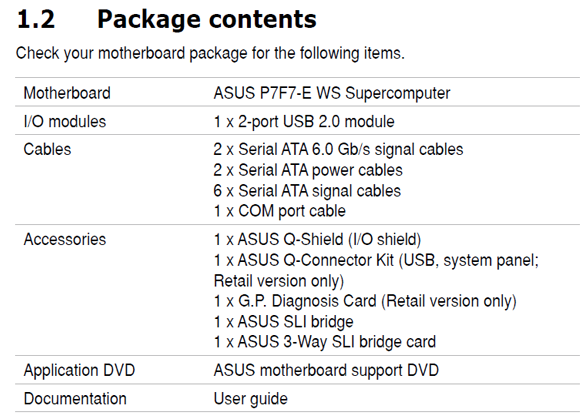
But not to worry, while we cannot show you what the box is going to look like, we can certainly tell you what you will get inside it.
You can also head over to NewEgg.com and look at their image gallery to see the box.
The Motherboard
The Board
One of the things that I noticed right off the bat with the ASUS P7F7-E is the layout of the lower half of the board. It is very clear from this and from the marketing on the product that you are buying a board designed to use multiple GPUs. This is a key factor to this board. But before we get into all of that, let's look at the general layout and features.
Starting off at our usual spot, we see that ASUS has dropped on an extra pair of RAM slots. This will be good news for many professional users. Although you cannot load this board up with six 4GB modules (the max is still 16GB of addressable RAM), you can extend the amount of RAM you can use without spending a ton of money.
To get 16GB with four slots you are going to pay quite a bit more than you would if you are using the P7F7-E WS. On the opposite side you can also extend out to 12GB spending much less money as well. For some reason ASUS put an extra 4-pin Molex connector for board power up here; while the extra power is nice, the location is a tad awkward.
At the top of the RAM slots are three switches. As this is an ASUS board first and foremost, these are there to give you some overvolting options. You can extend the voltage available to the CPU, IMC and RAM.
Looking at the CPU socket, we find the familiar heatpipe layout. This is the same layout we saw on the P7P55 WS. The tall blue heatsinks are something of a fixture for the Intel based WS boards. Despite its cramped appearance, there is still plenty of room around the CPU for large air coolers and even our large Hyper 212 with two fans fit without issue.
Although the tall heatsinks are nice and provide excellent cooling, they do get in the way of plugging in the 8-pin Aux power cable. I think this one little plug is going to be an issue on just about any new high-end ATX board. To be honest with you, while this is an issue that is repeated over and over again with just about every manufacturer, it is not something they can do much about. This plug needs to be in close proximity to the CPU. The reason for this is that the traces (the small lines crisscrossing the board) cannot run power like this over long distances efficiently.
Moving down to the lower half of the board, you can see the well-spaced slots for all of your GPUs. Of course, not all of these are fully x16 electrical. The two blue are x16 (thanks to the NF200 bridge) and the two black are x8. In between each of these is more than enough space to accommodate a dual height cooler (if you do not use the x1 slots). The board fully supports Tri SLI and Quad Crossfire. It also supports up to four NVIDIA Tesla GPUs (if you are using a Clarkdale CPU).
Here we see the six SATA II and two SATA 3.0 ports as well as two internal USB ports. These USB ports are ideal for software dongles for applications like Lightwave 3D, etc.
To ensure that the SATA 3.0 and USB 3.0 ports get enough bandwidth, ASUS has dropped a PLX bridge onto the board. This gives the extra PCIe Gen 2.0 lanes needed to keep the data flowing.
The PLX bridge is, according to ASUS, a much better method for controlling both SATA 3.0 and USB 3.0 on the P55 and H5x boards. It has multiple PCIe Gen 2.0 lanes that it then translates back to a x4 Gen 1.0 lane to the chipset.
The upshot of this is that the Marvell and NEC controllers have all the bandwidth they need while the PLX bridge is responsible for handling the data transfer back to the P55 MCP. There is a small amount of latency with this, but in the end it is a much cleaner solution.
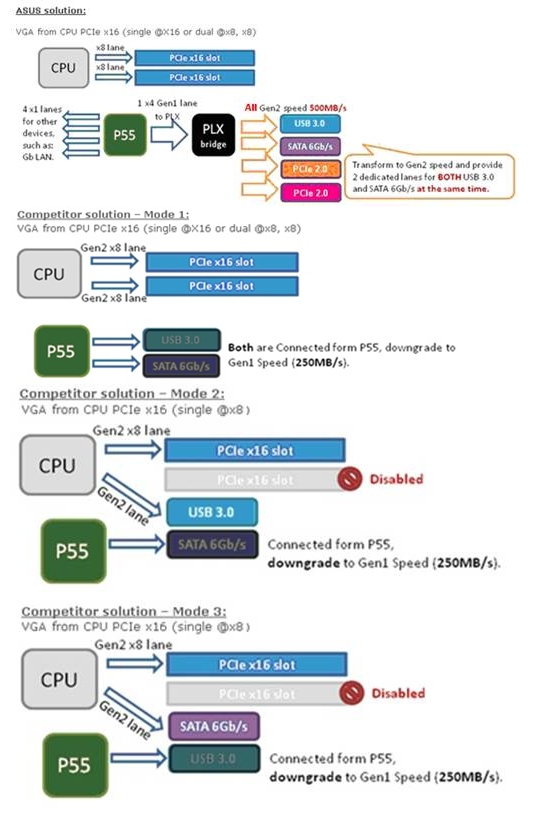
Looking at the ports on the I/O panel, you will see that ASUS has thrown in a pair of Firewire 800 ports as well as two LAN ports.
Now, the extra LAN port is nothing new, but the fact that these ports can be teamed using 802.3ad Link Aggregation Protocol and load balancing/ failover is. The LAN ports are controlled by RealTek 8112L chips which offer Gbe connection across both (up to 2GB with teaming).
The ASUS P7F7-E WS is a well laid out board for its intended use. It is very much designed to be either a professional content creation board (primarily graphical or video) or a computational monster. The four available PCIe x16 mechanical slots give some amazing freedom in your choice of GPU. This is especially true if you are using Adobe CS5 products; you can get a pretty big boost if you are using NVIDIA Quadros and Premier.
BIOS and Overclocking
BIOS
The BIOS on the P7F7-E WS follows the AMI layout as usual. Also as usual are the heavy overclocking features that ASUS stuffs into the board. These are found on the AI Tweaker Page.
Inside the AI Tweaker page are a few sub menus that give you greater control over your CPU and memory.
There are also some pretty cool fan options in the BIOS. Along with the auto controls, ASUS has added in some manual ones that are very nice.
Overclocking
Overclocking the P7F7-E WS was as easy as overclocking any ASUS board. As per our usual methods, we started with the "CPU LevelUP!" to get our base. From there we pushed forward until we finally hit a high of 185 x 22 for a recorded stable clock of 4.083GHz. The voltages to achieve this were pretty mild in comparison to some of the other boards we have tinkered with. The CPU was only at 1.38V and CPU PLL are also low at 1.9V.
You can see the validation for our overclock here.
It is pretty impressive to have this type of overclocking headroom on a professional level board. Normally overclocking is left out completely.
TurboV EVO
The ASUS TurboV is probably my favorite overclocking software. It is simple, clean and powerful. The only thing that it lacks is the ability to drop the memory multiplier using the manual clocking tools. I am sure there is a reason for this omission, but it would be nice to see it in a future revision of the software.
Here you can see your system status at a glance as well as overclock the CPU, memory and GPU fairly quickly.
Included with the overclocking tools is also an easy tool to get your CPU moving. This is the CPU LevelUP feature.
The last item on the TurboV list is the Turbo Key utility. Here you can set a key stroke pattern to automatically enable a present OC.
As all overclocking results are dependent on the hardware you use, your results may vary. Results of our overclocking tests are included in the performance section with the stock scores. It is also important to point out that when overclocking memory performance may vary greatly due to different memory multipliers. As such there is no real "apples to apples" comparison. We include the overclocked performance to show the potential performance you can get form pushing the boards we have in hand.
Important Editor Note: Our maximum overclocking result is the best result we managed in our limited time of testing the motherboard. Due to time constraints we weren't able to tweak the motherboard to the absolute maximum and find the highest possible FSB, as this could take days to find properly. We do however spend at least a few hours overclocking every motherboard to try and find the highest possible overclock in that time frame. You may or may not be able to overclock higher if you spend more time tweaking or as new BIOS updates are released. "Burn-in" time might also come into play if you believe in that.
Test System Setup and Comments
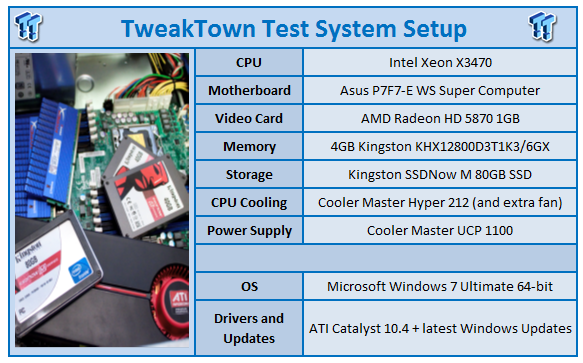
There are a few things that we found to be very cool about the P7F7-E WS. We are talking about features beyond the multi-GPU setup and the extra memory. One thing that stands out is the EPU and TPU software. These two combined (at stock speeds) help reduce the power draw on the system as well as balancing the thermal load.
But beyond that is the audio. Although some may think that Realtek has a better CODEC, personally I think the VIA VT2020 included with the P7F7E-WS has a cleaner, crisper sound.
The dual teamed LAN ports also are a great feature. The included software is excellent and actually works. For our testing we set the team up using the 802.3ad LACP; this allowed us to maintain 70+ MB/s transfer rates even on large files (2GB in size). Not bad at all, especially for video work.
The installation of the board went well. We had almost no issues with it other than a slight misunderstanding on our part. When we first received it we thought our Registered ECC DDR3 would work. However, the P7F7-E WS does not support ECC registered RAM. We ended up having to fall back on our standard DDR3 kit.
Synthetic Tests - Part I
With any system you will want to see a combination of synthetic testing and real-world. Synthetics give you a static, easily repeatable testing method that can be compared across multiple platforms. For our synthetic tests we use Everest Ultimate, Sisoft Sandra, FutureMark's 3DMark Vantage and PCMark Vantage, Cinebench as well as HyperPi. Each of these covers a different aspect of performance or a different angle of a certain type of performance.
Memory Bandwidth
Memory is a big part of current system performance. In most systems slow or flakey memory performance will impact almost every type of application you run. To test memory we use a combination of Sisoft Sandra, Everest and HyperPi 0.99.
Sisoft Sandra
Version and / or Patch Used: 2010c 1626
Developer Homepage: http://www.sisoftware.net
Product Homepage: http://www.sisoftware.net
Buy It Here
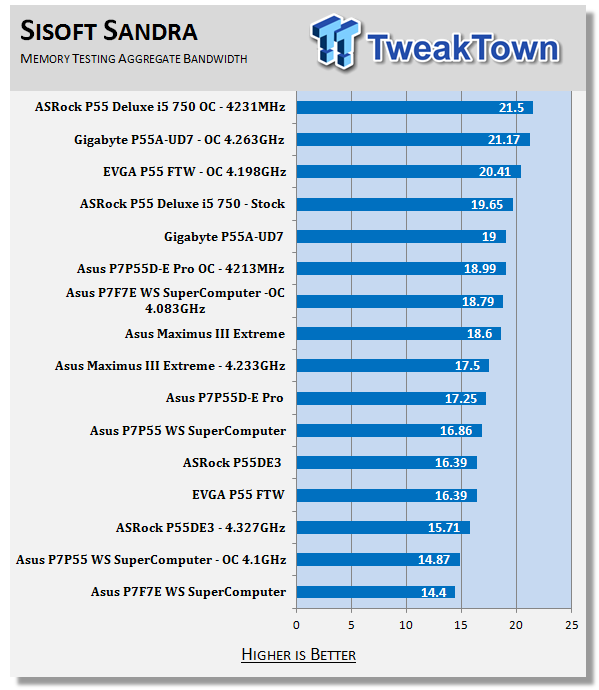
Stock memory performance leaves a lot to be desired. We see the P7F7-E at the bottom of the list, even at 1333MHz. We did see good performance when we overclocked the CPU, though. The poor memory showing could impact video editing and 3D animation later in the review.
Everest Ultimate
Version and / or Patch Used: 5.30.1983
Developer Homepage: http://www.lavalys.com
Product Homepage: http://www.lavalys.com
Buy It Here
Everest Ultimate is a suite of tests and utilities that can be used for system diagnostics and testing. For our purposes here we use their memory bandwidth test and see what the theoretical performance is.
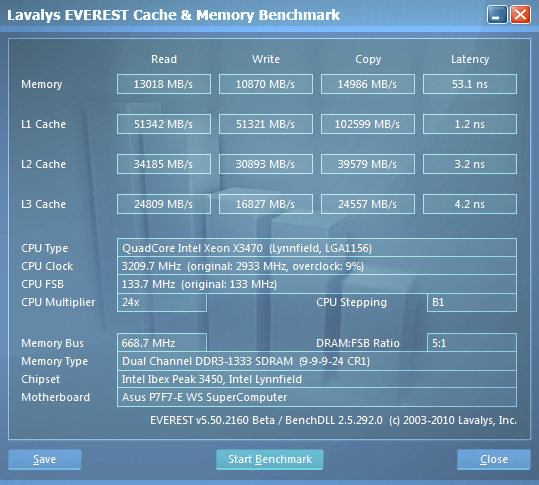
Stock Memory Performance
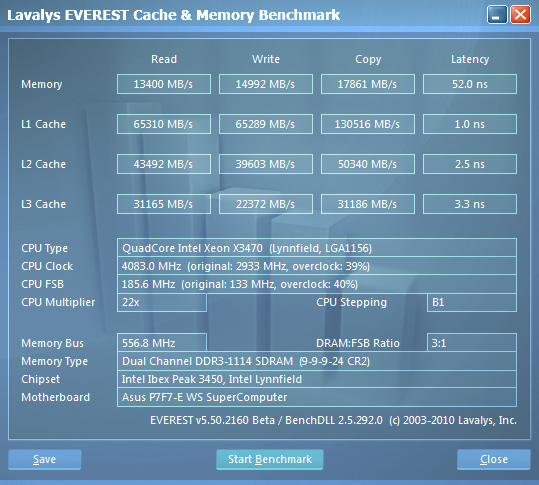
Overclocked Memory Performance
Everest shows the same thing with the memory performance here. It could be the extra RAM slots that are causing the issue, but it could also be that the Xeon is looking for the ECC feature as well.
HyperPi 0.99
Version and / or Patch Used: 0.99
Developer Homepage: www.virgilioborges.com.br
Product Homepage: www.virgilioborges.com.br
Download It Here
HyperPi is a front end for SuperPi that allows for multiple concurrent instances of SuperPi to be run on each core recognized by the system. It is very dependent on CPU to memory to HDD speed. The faster these components, the faster it is able to figure out the number Pi to the selected length.
For our testing we use the 32M run. This means that each of the four physical and four logical cores for the i7 and the four physical cores of the i5 is trying to calculate the number Pi out to 32 million decimal places. Each "run" is a comparative to ensure accuracy and any stability or performance issues in the loop mentioned above will cause errors in calculation.
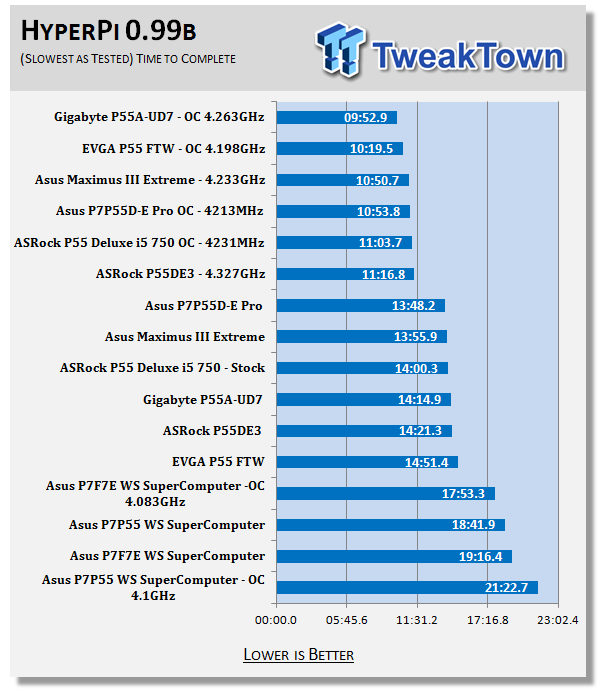
With the extra load on each CPU core, it is not surprising that we see the Xeons at the bottom here. After all, they are having to handle two 32M super pie runs per core. When you look at it that way, the performance we see here is not too bad.
Synthetic Tests - Part II
Disk Drive Controller
The system drive controller is an important part of system performance. In most modern boards your drive controller will run off of the PCI-e bus. The PCI-e bus performance can be affected by poor trace layout as well as many other design choices that show up on different boards.
For testing we use Sisoft's Sandra and Everest.
SiSoft Sandra
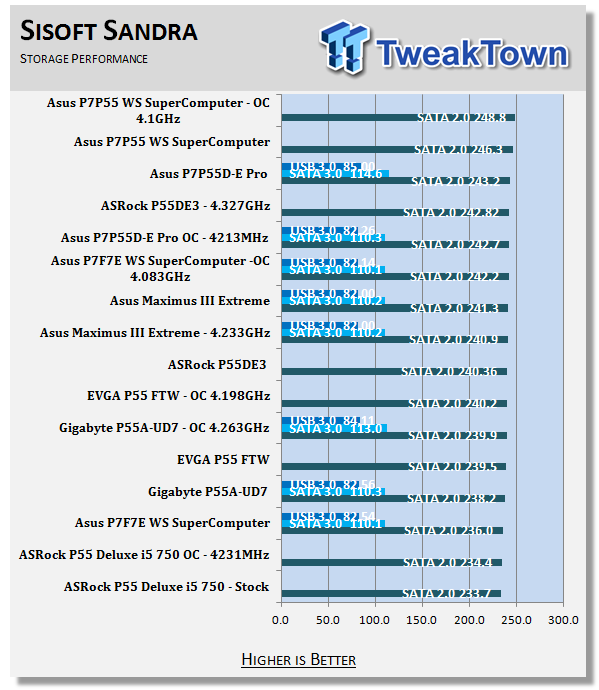
HDD performance was a little off for the SATA II controller, but SATA 3.0 and USB 3.0 performance is right on the money.
Everest
Stock HDD Performance
Overclocked HDD Performance
Stock USB 3.0 Performance
Overclocked USB 3.0 Performance
Everest shows us a little better performance, but it is still not up there with what we have seen form P55 based boards.
Synthetic Tests - Part III
Here is where we dig out the FutureMark tests.
PCMark Vantage
Version and / or Patch Used: 1.0.0.0
Developer Homepage: http://www.futuremark.com/
Product Homepage: www.futuremark.com
Buy It Here
For overall system performance we use PCMark Vantage. This is run in both x86 and x64 mode to give the best indication of performance.
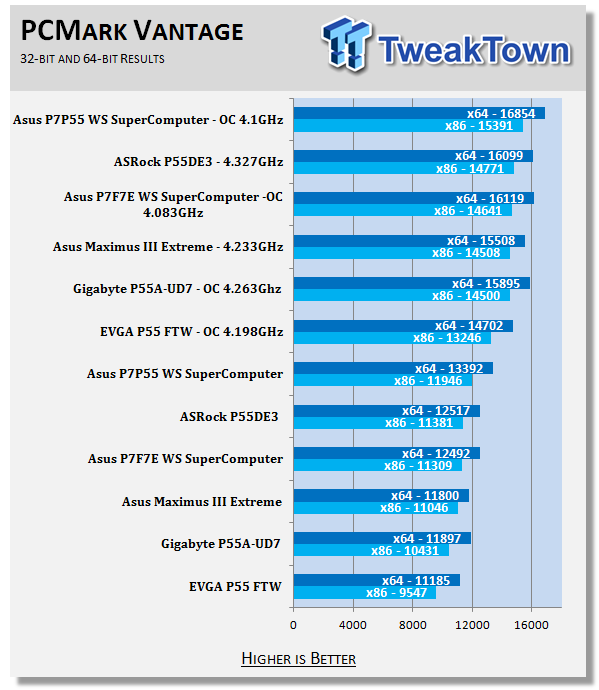
The P7F7-E WS does a great job at PCMark. During both the stock and overclocked runs it was in the top three. We have a feeling that the memory performance is showing its head here.
3DMark Vantage
Version and / or Patch Used: 1.0.1
Developer Homepage: http://www.futuremark.com/
Product Homepage: www.futuremark.com
Buy It Here
For synthetic gaming tests we used the industry standard and overlockers bragging tool 3DMark Vantage. This is a test that strives to mimic the impact modern games have on a system. Futuremark went a long way to change from the early days of graphics driven tests to a broader approach including physics, AI and more advanced graphics simulations.
3DMark Vantage uses the DX10 API in addition to having support for PhysX. As we are no longer using an NVIDIA GPU for testing (at least until we can get a GTX 4xx card) you will only see the CPU based PhysX results in the scores. For testing we use the Performance test run.
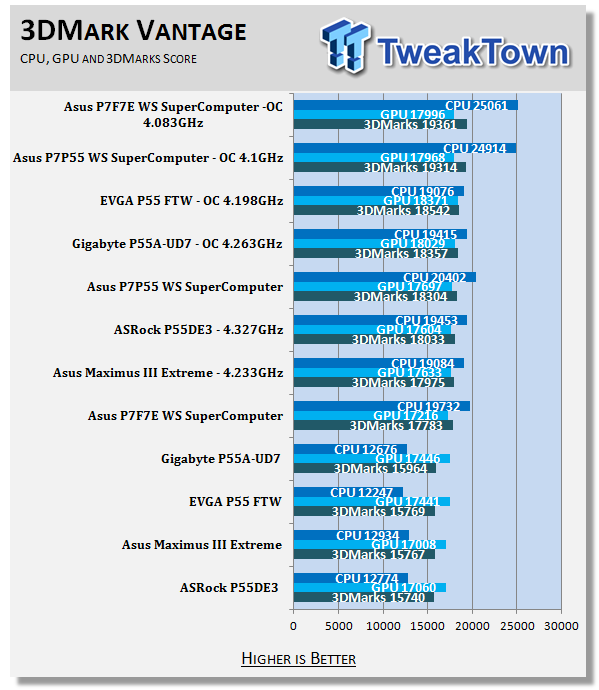
The P7F7-E WS does quite well in 3DMark. Here we see it right behind the P7P55 WS in our stock run and at the top of the pile for our overclocked run. It looks like this workstation board would be great for gaming, too.
Cinebench R11.5 x64
Version and / or Patch Used: R11.5 x64
Developer Homepage: http://www.maxon.net/
Product Homepage: www.maxon.net
Download It Here
Cinebench is a synthetic rendering tool developed by Maxon. Maxon is the same company that developed Cinema4D, another industry leading 3D Animation application. Cinebench R11.5 tests your systems ability to render across a single and multiple CPU cores. It also tests your systems ability to process OpenGL information.
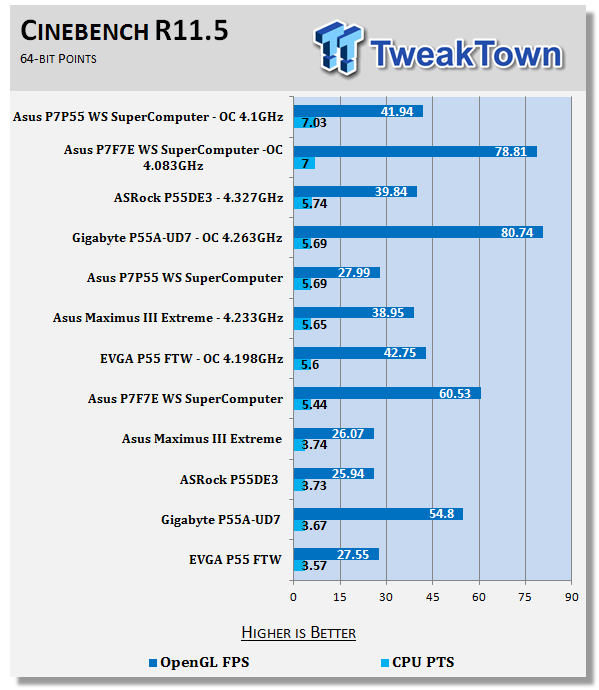
The Cinebench numbers are also good, but we do see a little of the HDD and memory performance showing here. While the score is just behind the P7P55 WS, because of its faster memory and HDD performance it is able to top things here fairly easily.
Real-World Tests - Part I
Real-world testing allows us to see how well a product will perform when used in the same manner as it would be in your house or office. It is an important side to performance testing as it can uncover hidden glitches in the way a product performs.
It is especially true when testing a mainboard; there are so many components of a board that have to interact that any problems between parts can cause a failure of the whole.
For real-world testing we use some common applications and functions. We test with LightWave 3D for rendering performance, AutoGK for transcoding from DVD to AVI and two games for gaming testing.
Rendering
Rendering of 3D Animation is a system intensive endeavor. You need a good CPU, memory and HDD speed to get good rendering times. For our testing we use LightWave 3D. This software from Newtek is an industry standard and has several pre-loaded scenes for us to use.
LightWave 3D
Version and / or Patch Used: 9.6
Developer Homepage: http://www.newtek.com
Product Homepage: http://www.newtek.com/lightwave/
Buy It Here
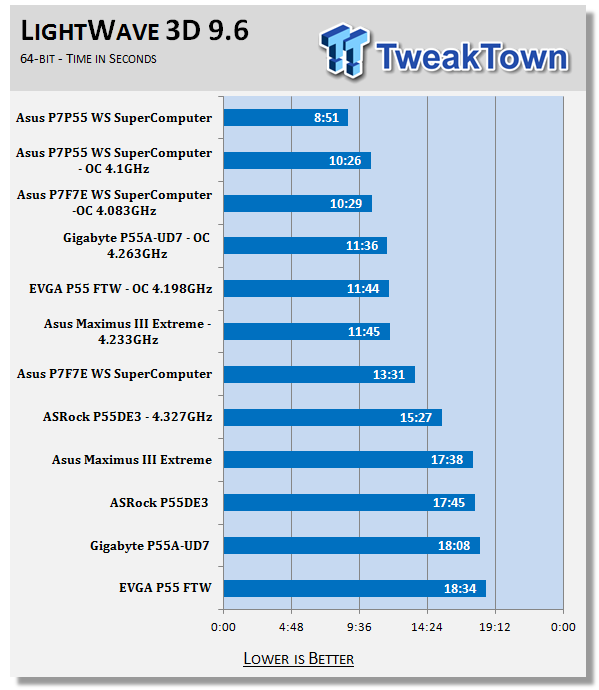
The performance here is most impressive. Granted, it is a little skewed as the two WS boards in the rankings are sporting an 8-thread CPU. Still, it is nice to see this level of performance from the workstation boards in an industry standard test.
AutoGK
Version and / or Patch Used: 2.55
Developer Homepage: http://www.autogk.me.uk/
Product Homepage: http://www.autogk.me.uk/
Download It Here
AutoGK stands for Auto Gordian Knot; it is a suite of transcoding tools that are compiled into an easy to install and use utility. It allows you to transcode non-protected DVDs and other media to Xvid or Divx format. For our testing purposes we use a non-DRM restricted movie that is roughly 2 hours in length. This is transcoded to a single Xvid AVI at 100% quality.
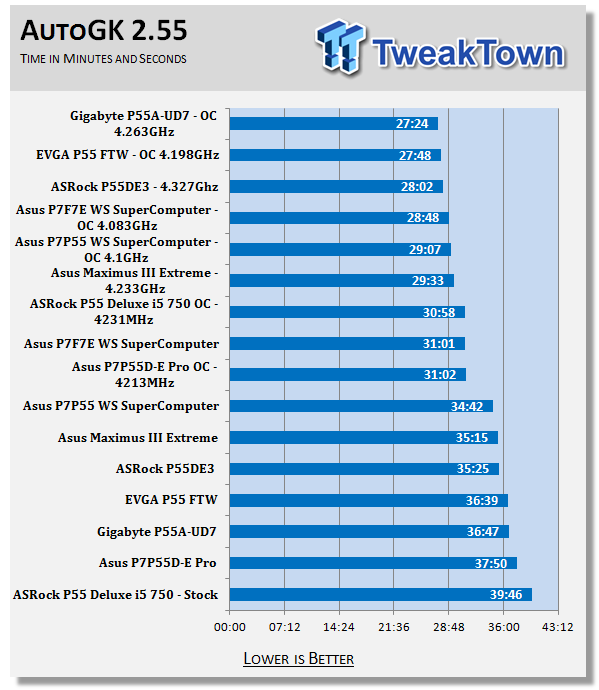
AutoGK performance was ok; it was not good, but it was not bad. This was probably due to the memory and HDD performance problems we saw before.
Real-World Tests Part II
Here we have our real gaming tests. Each of the games we chose use multiple cores and GPUs. They are able to stress the system through use of good AI. Both have decent positional audio that adds impact to the sound subsystem of the board. We ran each game through the level or parts listed and recorded frames per second using FRAPS. This brings the whole game into play.
*** A word on gaming as a motherboard test ***
Despite the fact that most games are very GPU limited, we are still noticing HDD and even audio creating issues in gaming performance. Because of this you may see differences in the number of frames rendered per second between different boards. Usually the difference is very small, but occasionally because of bad tracing, poor memory or HDD performance, this difference is significant. The issues are often more prevalent in older versions of DirectX, but can still pop up in DX10 and 11.
Call of Duty Modern Warfare 2 (DX9)
Version and / or Patch Used: 1.0
Timedemo or Level Used: First combat until the school is cleared
Developer Homepage: http://www.infinityward.com
Product Homepage: http://modernwarfare2.infinityward.com
Most of you know about the game Modern Warfare 2; it caused quite a bit of controversy in the latter half of 2009. The game is a first person shooter with a heavy combat emphasis. It follows the events in the first Modern Warfare very closely and brings back several characters from the original.
As with most games in the Call of Duty franchise, it features a heavy AI load. This is not because of a complex AI routine, but more due to the sheer number of enemies in any given combat situation. It is also our single DX9 based game in our testing suite. Settings are shown below.
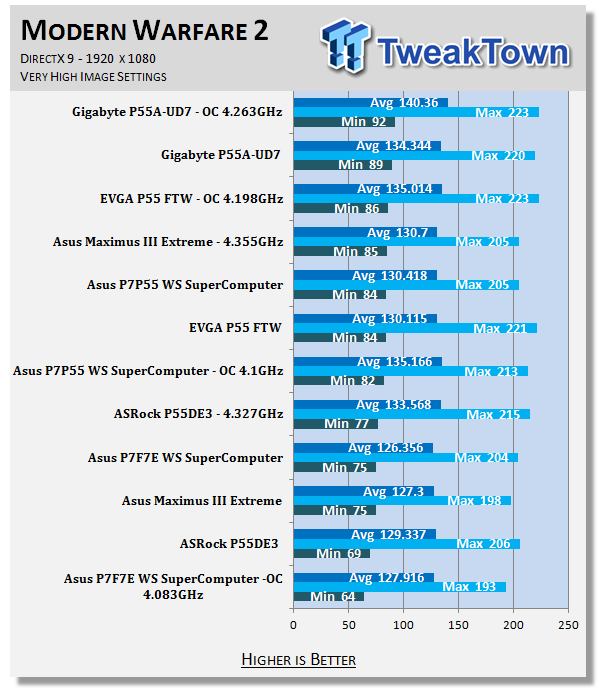
Ok, so the P7F7-E WS combined with a Xeon X3470 and HD 5870 GPU is not the right combo for Modern Warfare 2. But then again, at 100+ FPS average and 65+ FOS at minimum, who would really complain?
Far Cry 2 (DX10)
Version and / or Patch Used: V1.00
Timedemo or Level Used: Clearing the Safe house through to the Rescue
Developer Homepage: http://www.ubi.com
Product Homepage: http://farcry.us.ubi.com
Far Cry 2 is a large sandbox style game. There are no levels here so as you move about the island you are on you do not have to wait for the "loading" sign to go away. It is mission driven so each mission is what you would normally think of as the next "level".
In the game you take the role of a mercenary who has been sent to kill the Jackal. Unfortunately your malaria kicks in and you end up being found by him. Long story short, you become the errand boy for a local militia leader and run all over the island doing his bidding. Settings we used for testing are shown below.
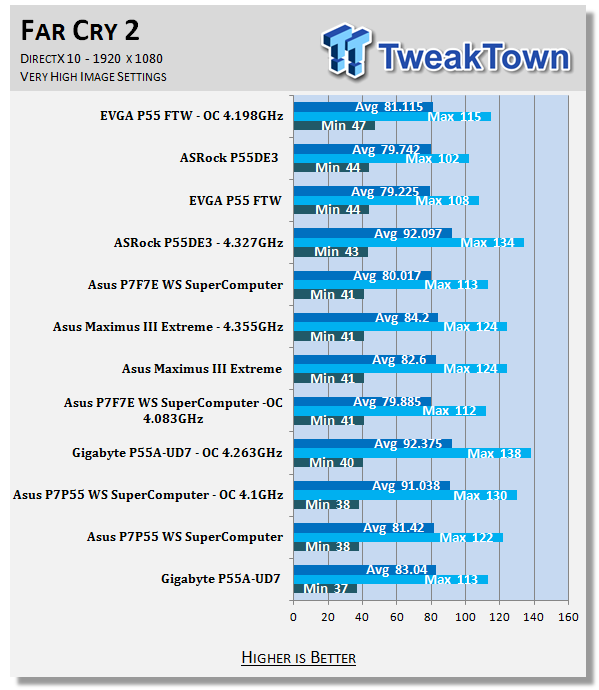
In Far Cry 2 things are a little better. Here we see the minimum FPS over 40 for the P7F7-E WS. Again, at speeds like this most people would not notice or care about the difference between the boards we tested (for gaming at least).
Battlefield Bad Company 2 (DX11)
Version and / or Patch Used: V1.00
Timedemo or Level Used: From washing up on the beach to the mine fields.
Developer Homepage: http://www.ea.com/
Product Homepage: http://badcompany2.ea.com/
Battlefield Bad Company is another sequel and also another game "franchise". Bad Company 2 is also our DX11 Shooter game. The game follows a fictitious B company team on a mission to recover a Japanese defector. This puts you back in World War II (at least for the beginning of the game) while the multi-player game is centered on much more modern combat. For our testing we used the single player mode. Settings are shown below.
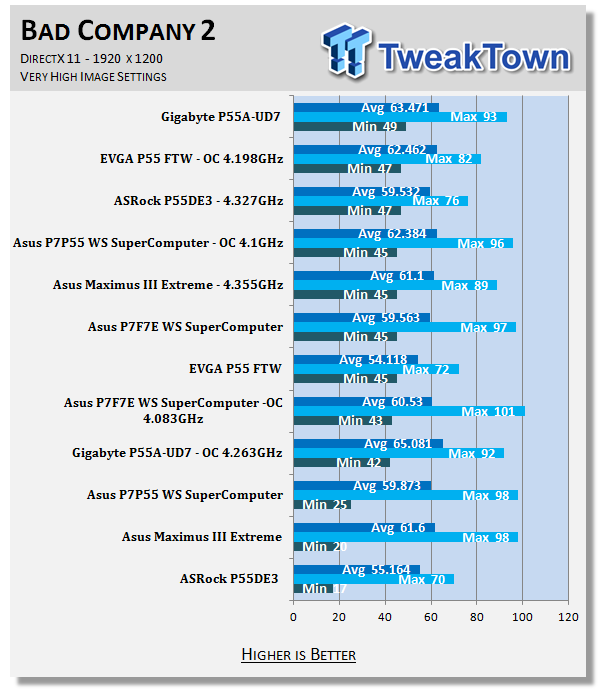
Again, not too shabby here. The performance is right in the middle of the group. So, while you won't have the fastest FPS out there, the P7F7-E will not slow you down either.
Gaming Conclusion
The P7F7-E WS was not the fastest board we tested as far as gaming goes. However, it is still pretty nimble and quick. The VT 2020 audio from VIA also added a nice little extra for the gamers out there. But, that is not all the P7F7-E WS has up its sleeve. There is the full support for Tri-SLI and Quad Crossfire that can boost your gaming enjoyment as well.
Power Usage and Heat Tests
Power Consumption
We are now able to find out what kind of power is being used by our test system and the associated graphics cards installed. Keep in mind; it tests the complete system (minus LCD monitor, which is plugged directly into an AC wall socket).
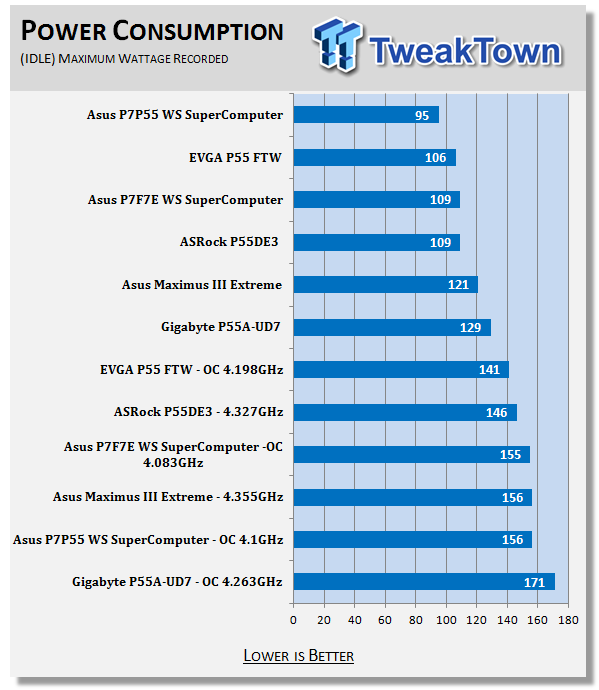
Power draw from the P7F7-E WS is good considering we tested it with a SATA 3.0 and USB 3.0 drive attached. The idle draw here is quite good, although this could change quickly with one or two Firewire 800 drives attached.
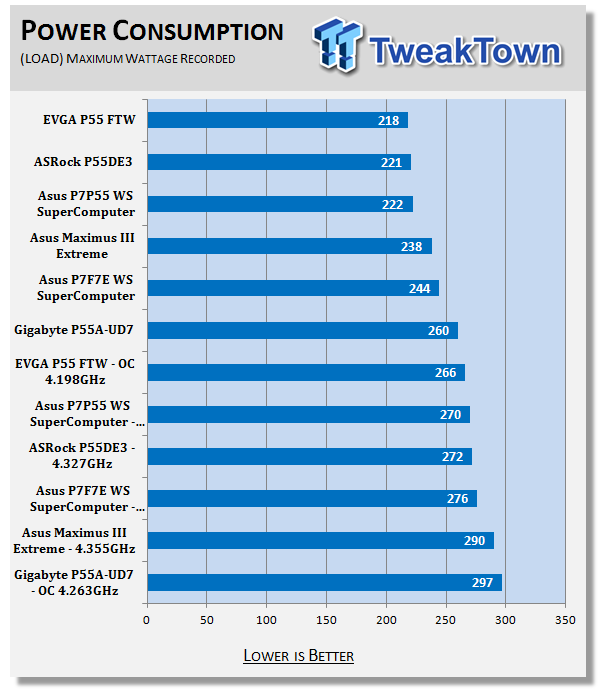
Under load the P7F7-E starts firing on all cylinders. We still see it show good power draw as the two boards that are in the lead here do not have SATA 3.0 or USB 3.0.
Heat Generation
As a new measure, we are now monitoring the heat generation from the key components on the motherboard; this being the Northbridge, Southbridge (if it contains one) as well as the Mosfets around the CPU. The results are recorded at idle and load during the power consumption tests.
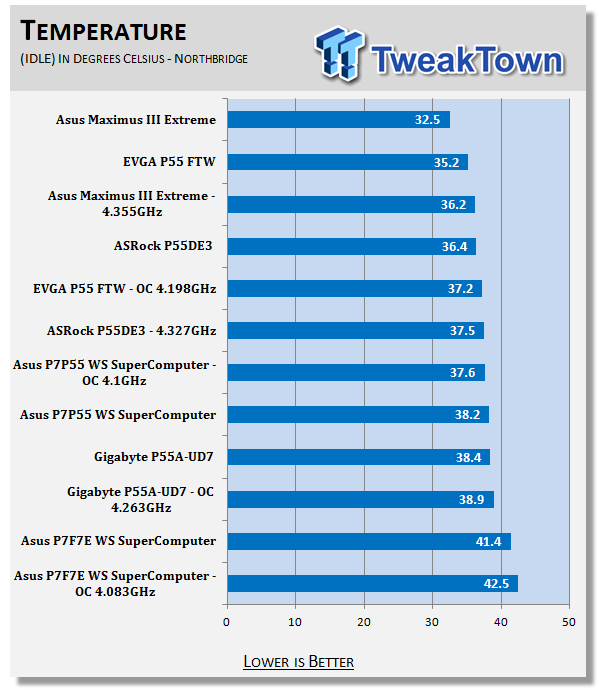
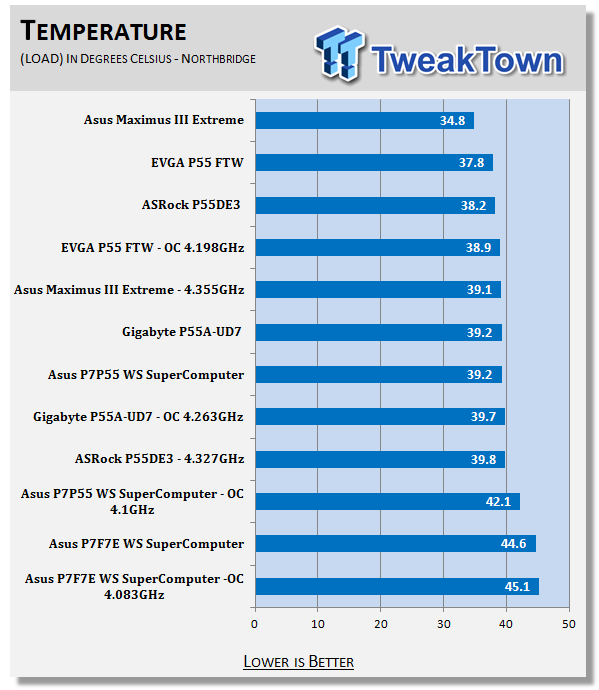
Heat is another story. It looks like the small heatsink at the end of the chain (there is an NF200 in the middle) is just not as efficient as some of the cooling on the enthusiast based products. It can keep the temps in the right envelope, but we would like to see a little better cooling.
Final Thoughts
When you think professional equipment, you think high-performance, high-cost. Well, that is not always the reality of professional level equipment. Nine times out of ten the Pro equipment (at least in the computer world) will be built for stability first and performance second. Because of this, there is usually very little in the way of tweaks and adjustments to get additional performance.
However, that was not the case at all with the ASUS P7F7-E WS and the entire WS line up. ASUS has stuffed in the same overclocking features you would find on their enthusiasts boards. ASUS has also made sure that you get many other features of their top-end products in their Workstation line. EPU6, T.Probe, TurboV, Turbo Key, MemOK!; all of these come over to the pro line up. This makes these boards even more attractive.
With the P7F7-E WS there is more on top of the good; you get the multi-GPU support and also a less expensive method of supporting large amounts of RAM. And the real kicker is the support for four Tesla GPUs when running a Clarkdale CPU. All this with a $290 price tag at NewEgg.com and it makes for a great product at a great price.

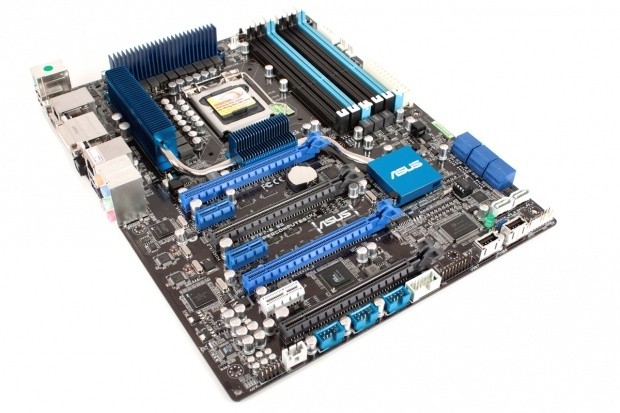
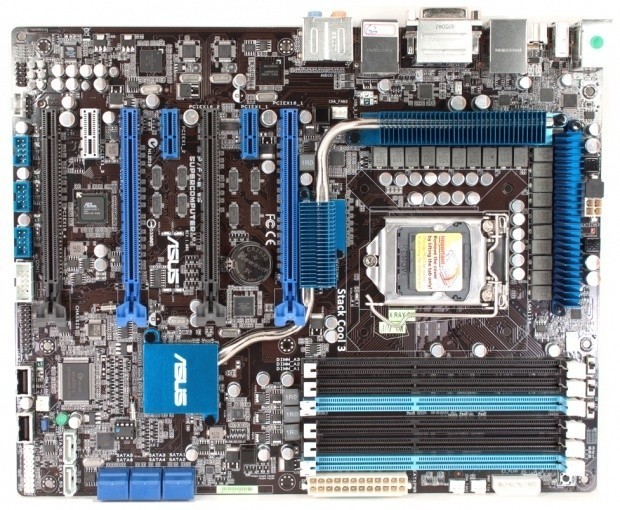

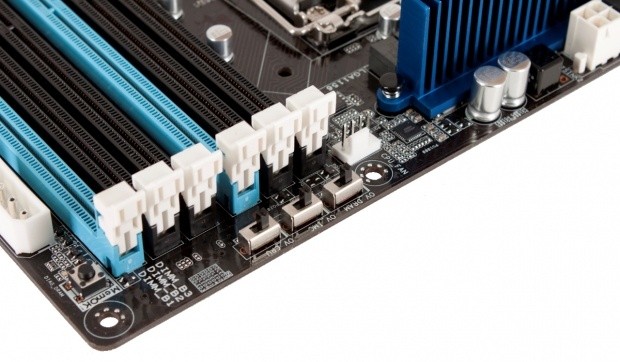
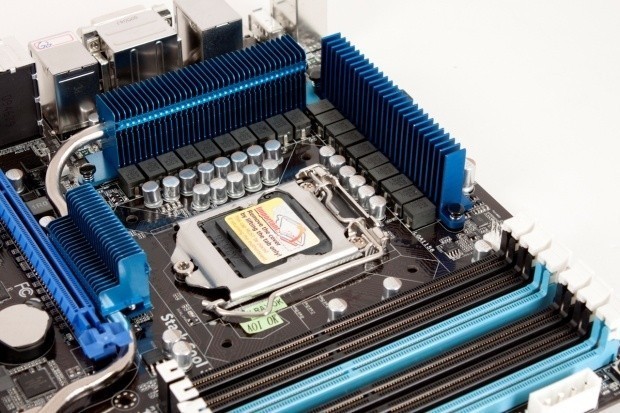

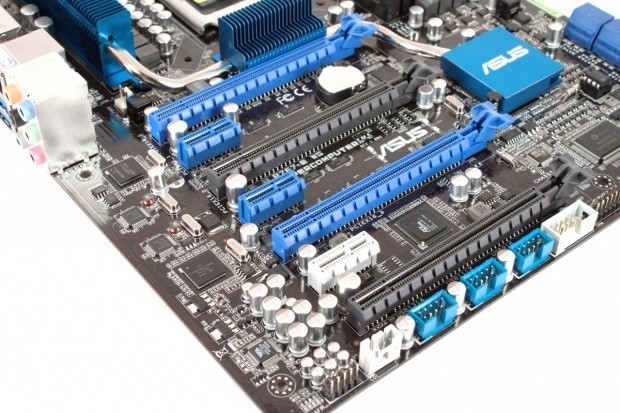

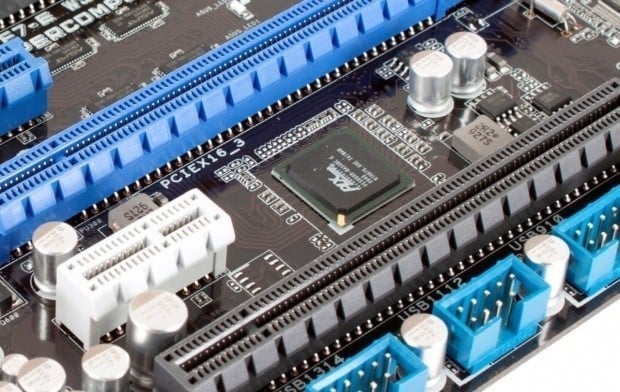
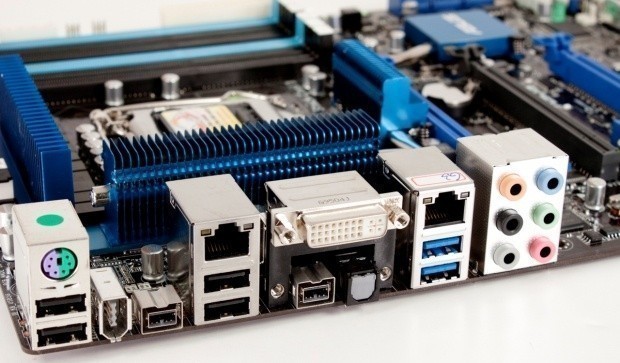





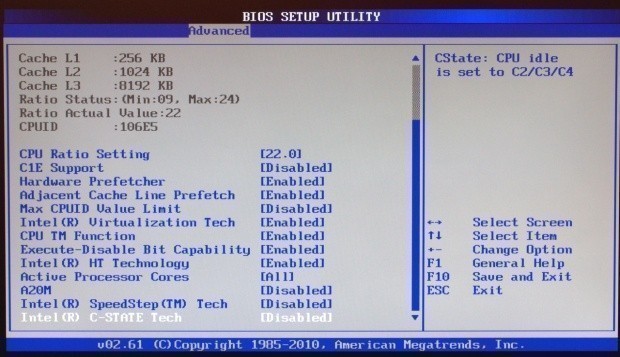
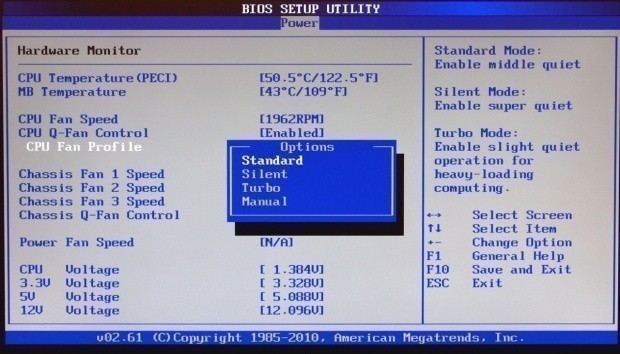

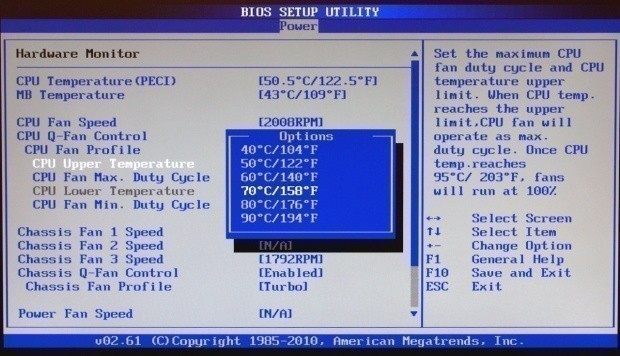
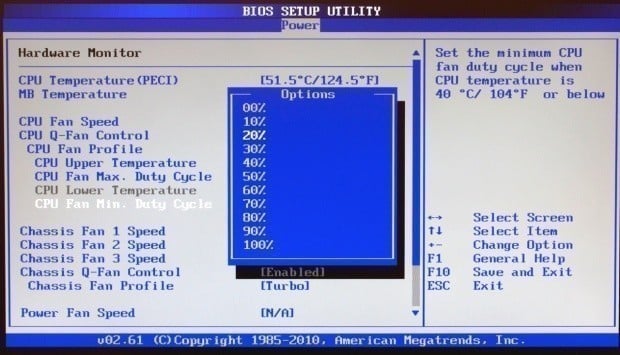

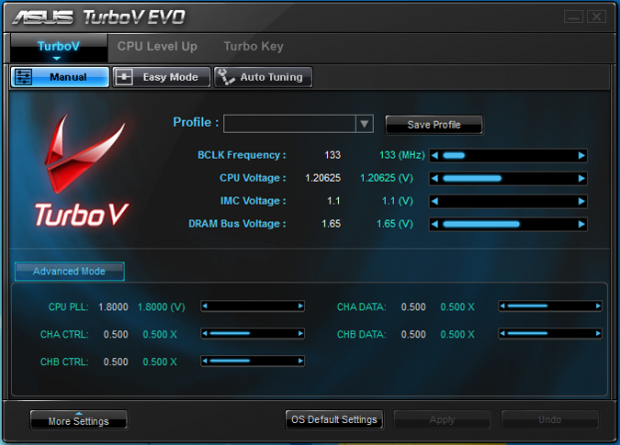
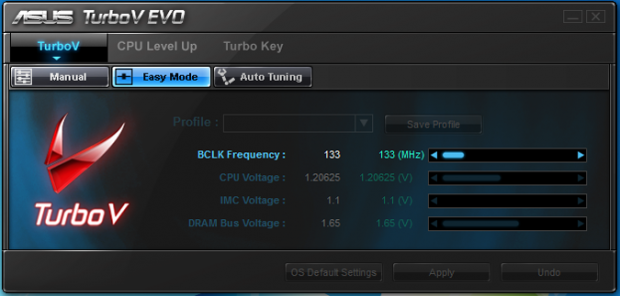
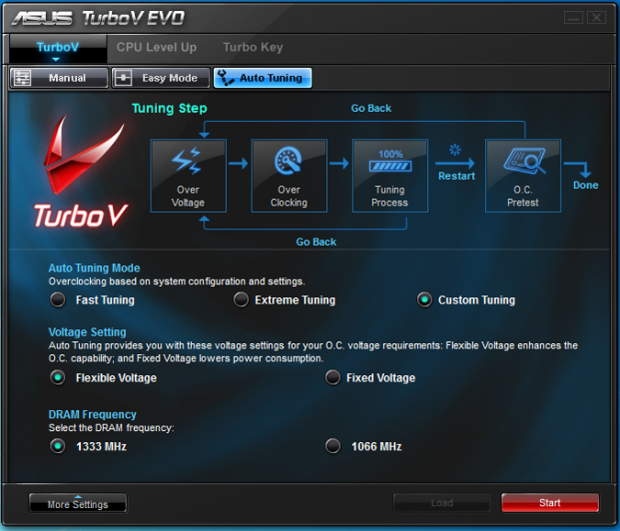



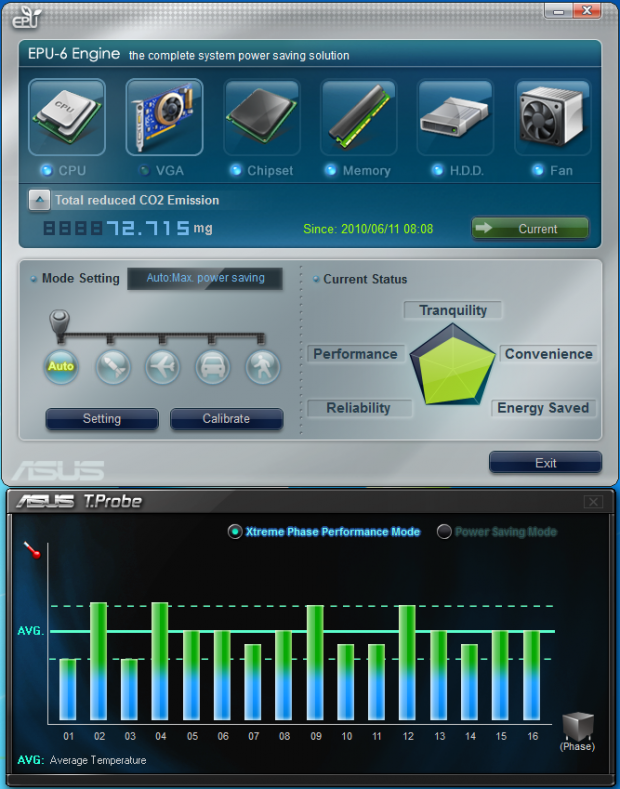












 United
States: Find other tech and computer products like this
over at
United
States: Find other tech and computer products like this
over at  United
Kingdom: Find other tech and computer products like this
over at
United
Kingdom: Find other tech and computer products like this
over at  Australia:
Find other tech and computer products like this over at
Australia:
Find other tech and computer products like this over at  Canada:
Find other tech and computer products like this over at
Canada:
Find other tech and computer products like this over at  Deutschland:
Finde andere Technik- und Computerprodukte wie dieses auf
Deutschland:
Finde andere Technik- und Computerprodukte wie dieses auf